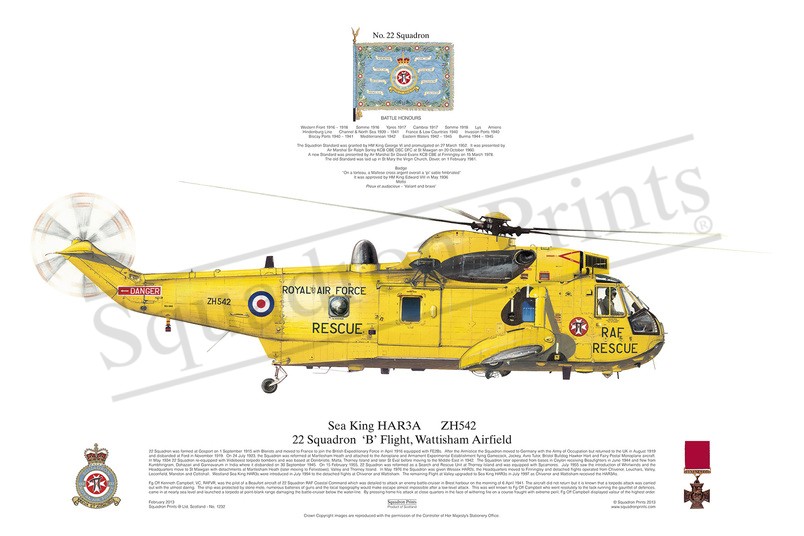#1232 Sea King HAR3A

Purchased products will not feature the Squadron Prints watermark
Description
Squadron Prints Lithograph No. 1232 - Sea King HAR3A, ZH542, 22 Squadron, \'B\' Flight, Wattisham Airfield.
22 Squadron was formed at Gosport on 1 September 1915 with Bleriots and moved to France to join the British Expeditionary Force in April 1916 equipped with FE2Bs. After the Armistice the Squadron moved to Germany with the Army of Occupation but returned to the UK in August 1919 and disbanded at Ford in November 1919. On 24 July 1923, the Squadron was reformed at Martlesham Heath and attached to the Aeroplane and Armament Experimental Establishment flying Gamecock, Jockey, Avro Tutor, Bristol Bulldog Hawker Hart and Fairy Postal Monoplane aircraft. In May 1934 22 Squadron re-equipped with Vildebeest torpedo bombers and was based at Donibristle, Malta, Thorney Island and later St Eval before moving to the Middle East in 1942. The Squadron later operated from bases in Ceylon receiving Beaufighters in June 1944 and flew from Kumbhirigram, Dohazari and Gannavarum in India where it disbanded on 30 September 1945. On 15 February 1955, 22 Squadron was reformed as a Search and Rescue Unit at Thorney Island and was equipped with Sycamores. July 1955 saw the introduction of Whirlwinds and the Headquarters move to St Mawgan with detachments at Martlesham Heath (later moving to Felixstowe), Valley and Thorney Island. In May 1976 the Squadron was given Wessex HAR2s, the Headquarters moved to Finningley and detached flights operated from Chivenor, Leuchars, Valley, Leconfield, Manston and Coltishall. Westland Sea King HAR3s were introduced in July 1994 to the detached flights at Chivenor and Wattisham. The remaining Flight at Valley upgraded to Sea King HAR3s in July 1997 as Chivenor and Wattisham received the HAR3As.
Fg Off Kenneth Campbell, VC, RAFVR, was the pilot of a Beaufort aircraft of 22 Squadron RAF Coastal Command which was detailed to attack an enemy battle-cruiser in Brest harbour on the morning of 6 April 1941. The aircraft did not return but it is known that a torpedo attack was carried out with the utmost daring. The ship was protected by stone mole, numerous batteries of guns and the local topography would make escape almost impossible after a low-level attack. This was well known to Fg Off Campbell who went resolutely to the task running the gauntlet of defences, came in at nearly sea level and launched a torpedo at point-blank range damaging the battle-cruiser below the water-line. By pressing home his attack at close quarters in the face of withering fire on a course fraught with extreme peril, Fg Off Campbell displayed valour of the highest order.
You may also like
-
RAF Puma Farewell Mug
18 Sqn84 Sqn; 28 Sqn; 33 Sqn; 22 Sqn; 230 Sqn; 72 Sqn; 27 Sqn; 1563 Flt; 240 OCURAF Benson
